At over $50 billion, the mobile gaming industry accounts for nearly half of all global gaming revenue. Last year, mobile gaming apps accounted for more than 80% of all app revenue from both the Apple App Store and Google Play Store, and there is no sign of this growth slowing down. In fact, global games research firm Newzoo forecasts that games will account for 72% of total global app revenues, or $58.1 billion, by 2020.
With games being such a profitable and growing industry, it’s increasingly difficult to capture installs and differentiate your game from others. Based on our work with some of the leading game developers, we’ve found that the average conversion rate (CVR) in the gaming category is 27-30%. This means about 70% of people land on your game page and decide not to install.
The most effective way to cut through the clutter and increase your chance of driving conversion is through the implementation of a clear App Store Optimization (ASO) strategy. By optimizing the creative assets on your game’s app store page, you can potentially boost CVR by up to 40%.
To help guide your optimization efforts, we’ve identified 3 essential ASO tips for gaming apps to help drive quality installs and boost CVR. But before we get into the details, let’s take a look at the mobile game industry as a whole.
Overview of the Mobile Game Landscape
There are three main categories in the mobile game industry—casual games, midcore games, and hardcore games.

Spectrum inspired by Deconstructor of Fun
Casual games are those with mass appeal. The gameplay is straightforward and and the games themselves are characterized by more minimalistic interfaces and simple mechanics. They can be played in short sessions and don’t take much time to master. The players of casual games tend to be those who download games just to pass the time, which means their sessions are short, albeit frequent. While lifetime value (LTV) is relatively low, casual games have traditionally racked up the most installs. Although the potential audience for these games is huge, the market is saturated. This creates the challenge of rising above the noise in such a crowded space and convincing users to install your game over others.
On the other end of the spectrum are hardcore games, which have a relatively narrower audience on mobile. These games have intricate storylines with complexity and depth, similar to games that are played on desktop or console. They are more challenging and require players to spend additional time and effort learning how to play and master. As opposed to casual games, the hardcore market is much smaller, but the customer LTV is typically much higher. With those two distinct types of games proving to be massively successful in the app stores, it opened up the opportunity for midcore games to enter the market and attempt to grab both pieces of the pie.
Midcore games are, as Deconstructor of Fun aptly puts it, a lighter and more accessible take on a hardcore theme or genre. With midcore games, the trend is to take elements of casual games (e.g., Match 3 or bubble shooter gameplay) and attempt to seamlessly combine it with certain aspects of hardcore games [e.g., tactical battles, evolving characters, strategy/adventure, role-playing games (RPG), etcetera]. This allows developers to combine the scale of casual users with the monetization of hardcore gamers.
Although these games take less time to master, they still have enough depth and substance in their narrative to convert some of the hardcore gamers. Because of this, they represent a significant opportunity in this crowded game market. In fact, based on Sensor Tower’s 2017 list of top mobile games by revenue, midcore games represented 95% of games on that list.
Given the growing trend of midcore games and their huge market potential, our tips will focus on games in this category.
Tip 1 – Identify your game’s unique positioning along the midcore spectrum
Since midcore games fall somewhere in the middle of the game spectrum, there is slight ambiguity with the genre. The audience isn’t purely defined yet—it includes people who enjoy the more simple gameplay of bubble shooter or Match 3 games and those who prefer complex strategy games with narratives. Midcore games represent a blend of the two audiences, which is the biggest challenge when designing an app store page that should cater to both of these groups.
The key to overcoming this challenge is pinpointing what makes your game different and where it falls along the spectrum. What’s your game’s unique narrative? How are you creatively combining casual gameplay with a more hardcore theme or storyline? The positioning you identify from the start will serve as the foundation of your testing strategy.
Since you can’t have two app stores at once, you need to strike the right balance when creating your app store assets. It’s imperative to find the best way to showcase the core, casual elements of your game with the more sophisticated, unique features (e.g., the distinct tactical strategy or storyline of your game) that mid to hardcore gamers look for. It’s this unique blend that will differentiate your game in this category and drive conversion.
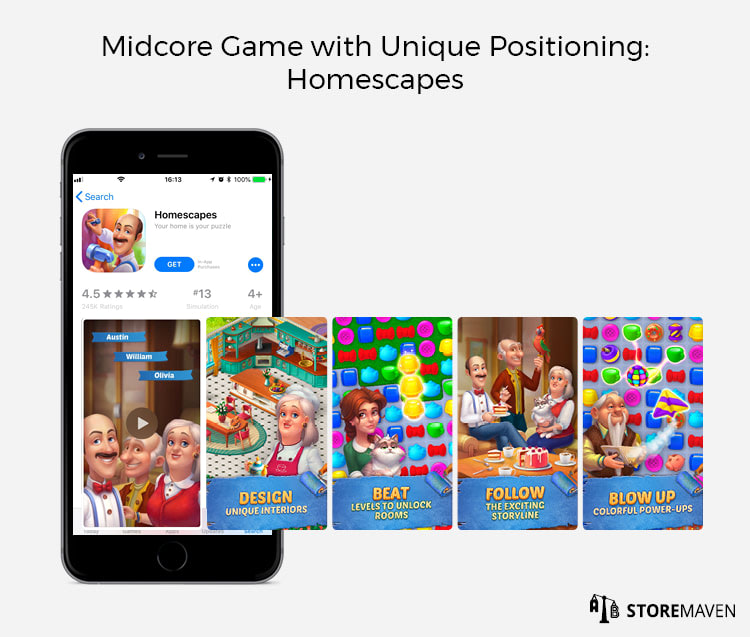
A great example of a game with distinct positioning and delicate balance is Homescapes. Their unique twist on the Match 3 gameplay is incorporating the storyline of decorating rooms in a mansion while interacting with characters and unlocking chapters in their story. As soon as you land on their Product Page, this differentiating factor is apparent. The Video and remaining Gallery assets strike an effective balance between showing the Match 3 game elements while also explaining that the puzzle gameplay allows players to experience the narrative of unlocking new rooms and renovating the mansion.
You can also test how well your app store performs with different audiences along the spectrum. Do you want to give more prominence to the casual aspect of your game, or do you drive more conversion with highlighting the game’s storyline? Naturally, different audiences will have different preferences. The optimal page for hardcore gamers is not the optimal one for casual gamers. However, there’s an option to create the right balance. It’s key to analyze the returns you’re getting from these audiences and strategically decide which audience is a higher priority. Testing with multiple audiences lets you optimize while ensuring you’re not significantly compromising one audience over another.
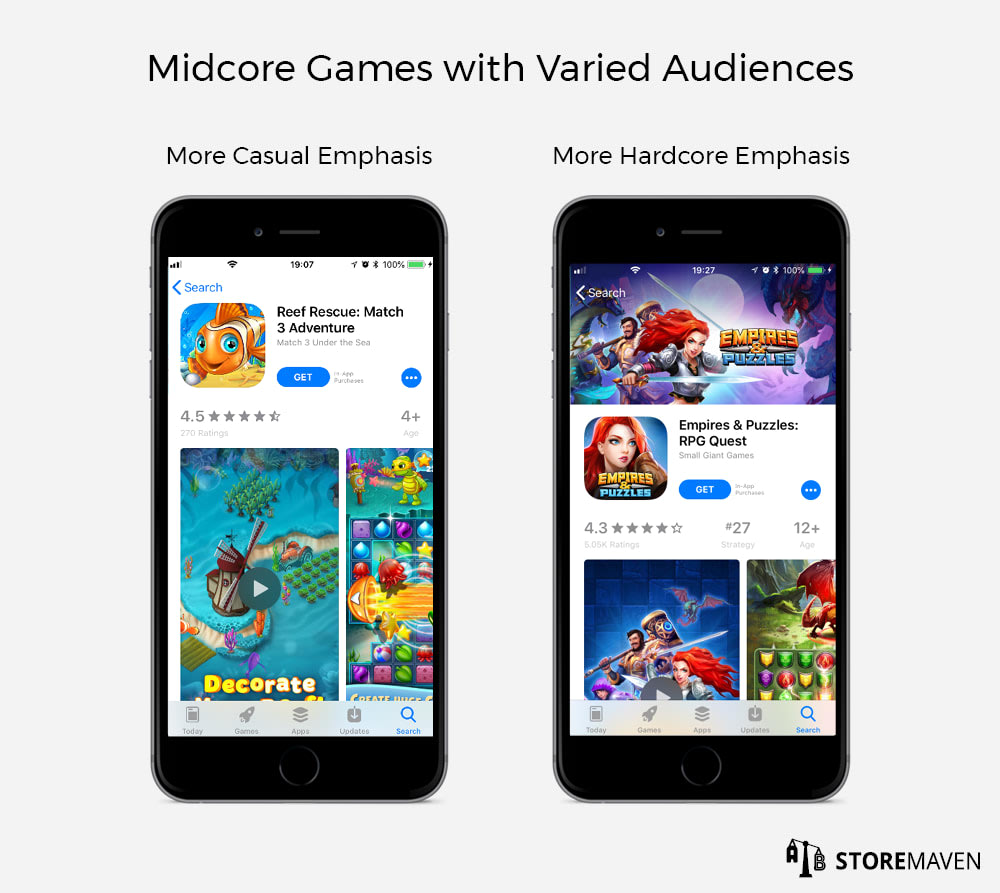
For example, Reef Rescue: Match 3 Adventure combines casual Match 3 play with the storyline of completing puzzles to rescue fish, build your reef, and unlock treasure. This is a lighter take on the midcore genre, and it’s clear their strategy is to attract more of the more casual skewing gamers. On the other hand, Empires & Puzzles places more emphasis on the hardcore aspect with its unique spin on a tactical RPG with Match 3 battles to take on opponents, build war fortresses, level up heroes, and collect characters.
While the two games incorporate elements from both casual and hardcore genres, they differ slightly in their target audience and creative execution. It’s clear that their app stores are strategically designed to convey their distinct positioning along the midcore spectrum, but only through testing can they confirm whether they’ve successfully done so.
This strategy can also be an integral component of concept testing. If your pre-launch hypothesis is that you can attract a specific type of gamer, then it opens the opportunity for you to test a variety of concepts early on. You can begin to understand which casual game aspects or hardcore features drive installs from your target audience, and what art themes gamers respond best to. Once you understand the unique selling propositions (USPs) that drive the most conversion and identify the best way to display them, you can continue developing your game with marketing data to drive your hypotheses.
Overall, growth in this category comes from converting casual gamers while also attracting the hardcore players. Only then will you be able to achieve scale and profitability. Identifying your game’s USP (and confirming or even defining them through app store testing), is an effective way to give your midcore game a chance to gain traction.
Once you understand and solidify your positioning, you need to take different visitor behavior and engagement into account, which leads us to our next tip…
Tip 2 – Optimize for unique visitor behavior
Before getting into the unique visitor behavior of gamers, here’s a breakdown of the two types of visitors who land on your page:
- Decisive Visitors — Visitors who decide to install or leave without ever engaging with the page. These visitors are only exposed to creatives that appear in the First Impression Frame. Decisive Visitors represent 60% of all app store traffic.
- Exploring Visitors — Visitors who choose to browse through available content on an app store page to make a more informed decision before installing. Exploring Visitors represent the other 40% of all app store traffic.
Based on our work with the leading mobile game publishers, we’ve uncovered interesting behavior insights within the gaming industry.
To start, casual gamers tend to be 51% more decisive than mid or hardcore gamers. This makes sense because those who prefer more casual games don’t care to spend additional time or effort researching a game. They make a decision based on the assets they see in the First Impression Frame (everything above the fold). It’s important to note that 100% of app store visitors see these marketing assets, and an optimized First Impression can boost CVR by 26%. In order to effectively capture installs from these decisive gamers, you should optimize the First Impression Frame to clearly showcase the casual gameplay aspect.
But, when doing so, make sure you use the remaining assets to convince the hardcore gamers that there’s still enough substance in the game for them to find it intriguing and challenging. It’s easy to assume that hardcore gamers spend more time deciding which games they want to install, most likely because they end up spending much of their free time playing them. This is also supported by our data. We’ve found that hardcore gamers are 26% more exploratory, which means they’re more likely to engage with your page through actions such as scrolling through your Gallery, vertically browsing your app store page, watching your Video, etcetera. For this reason, consider designing a First Impression that’s geared to Decisive Visitors, but optimize the rest of the app store page assets to emphasize the narrative and unique theme of your game.
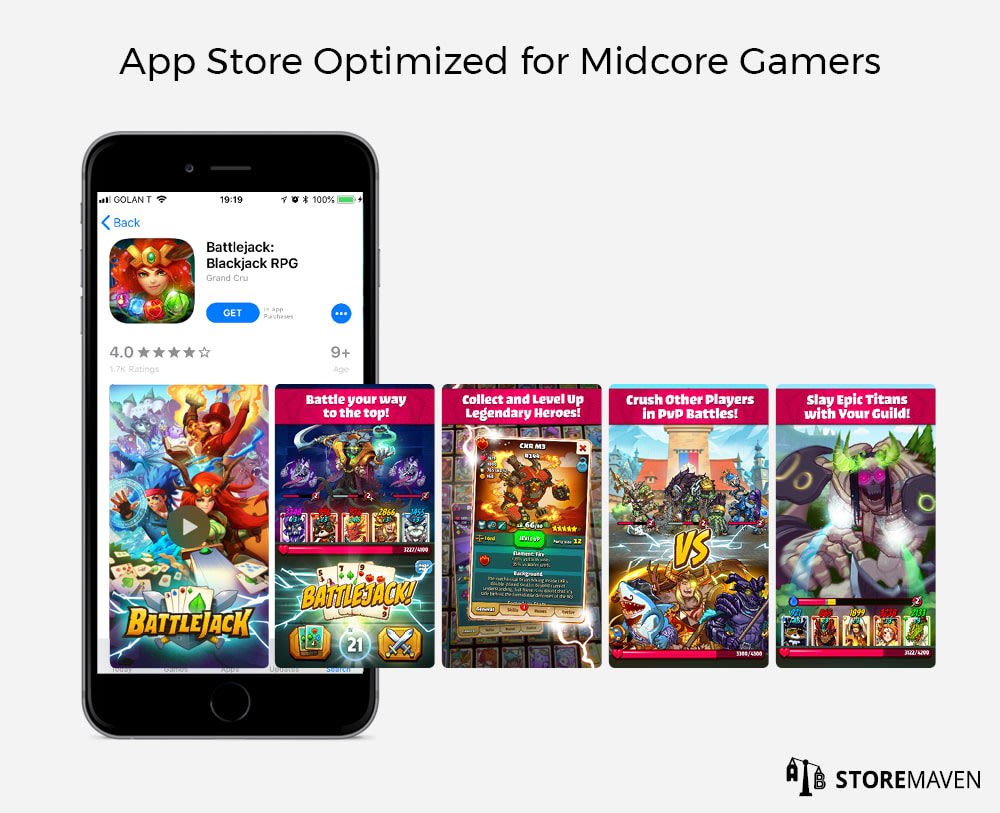
Battlejack: Blackjack RPG is effective at optimizing for both visitors. Within the First Impression, it’s clear that the core of the gameplay is blackjack, which is their way of attracting more casual gamers. However, they also appeal to hardcore players by creatively weaving the theme into the rest of the creatives. The remaining Gallery assets showcase the variety of characters and emphasize the unique game features such as exploring a world in which you can battle opponents, level up characters, and even create a guild. The game goes beyond just the basic card game of blackjack, and the creative assets clearly, and deliberately, show this.

Another unique way of optimizing for user behavior is to test the effectiveness of a gameplay GIF. By using a 3-6 second looping GIF Video, you can show a unique clip of gameplay or game features while keeping the length short enough to capture visitors’ attention regardless of their engagement level. And it’s successful in doing so. Based on tests we’ve run, including a GIF can lead to a 10% higher CVR and 17% higher direct install rate.
But please note that Apple have a minimum Video length requirement of 15 seconds, so you must loop the GIF in order to meet their guidelines.
Tip 3 – Character representation on your app store page is more important than you think
Now that you’ve identified where your game is positioned and have a sense of visitor behavior, you can focus on how you want to represent your game in the app stores through the characters and the overall art style of your page. Although it may seem obvious, you need to take the representation of your characters and art style seriously from the early stages of building your app marketing strategy.
Characters are a huge lure because they personify your game and bring it to life. Not to mention they are prevalent throughout every aspect of gameplay and are at the core of your game. Due to their importance, significant thought and strategy should go into how they’re represented on your app store page. Naturally, you will again need to find the right balance between incorporating casual and hardcore art styles, which we’ll explain below.
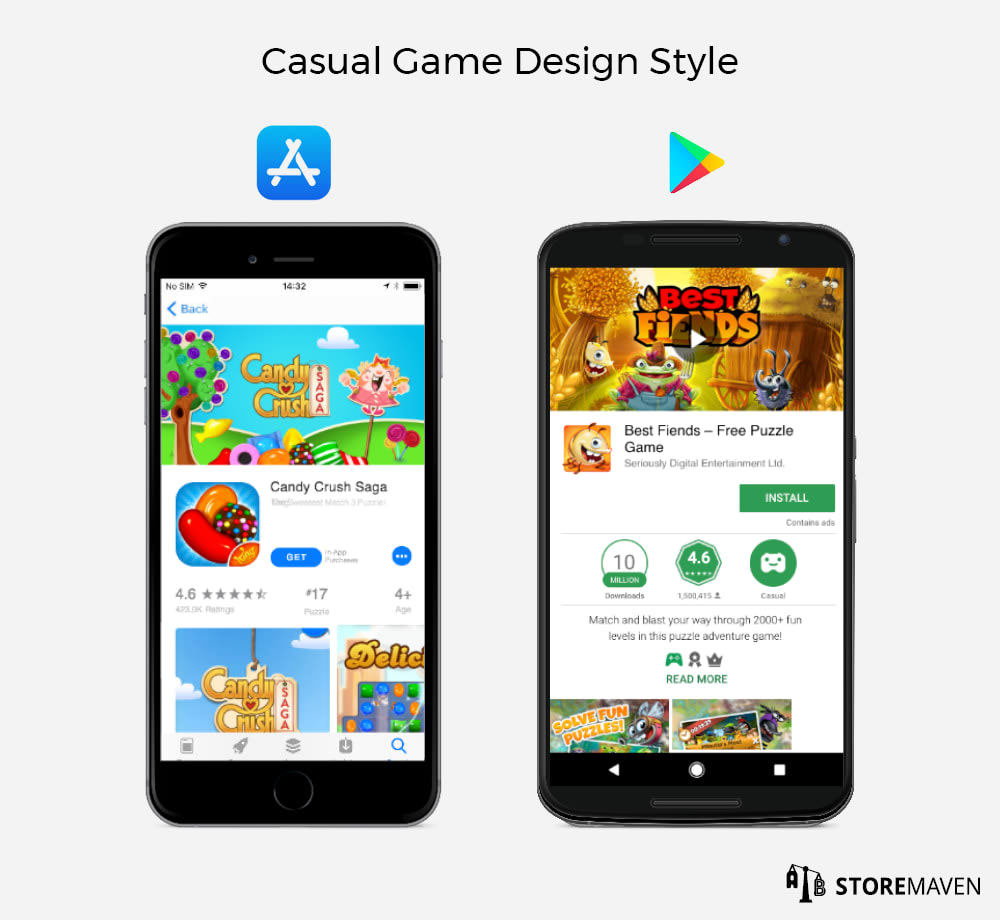
Casual games have distinct design styles. They tend to use bright, colorful assets coupled with adorable characters to attract casual gamers. The overall tone is light and uplifting to reflect the less intense nature of the games in this category. Because of their target audience, these app store pages usually offer a surface-level focus on the basic functionality and gameplay.
Hardcore games, on the other hand, typically use an art style with more elaborate, quality 3D graphics to showcase the high production value. This style also serves to mirror the quality of graphics that hardcore players are accustomed to experiencing on desktop and console. The characters are extremely realistic with detailed facial expressions, and since they’re a key component of the game’s theme, they’re usually front and center throughout all visual elements of the page. Overall, in contrast to casual games, we’ve seen a trend toward having a darker overall art style, both in the colors that are used and the gameplay elements shown that serve to emphasize the slightly more intense narratives.
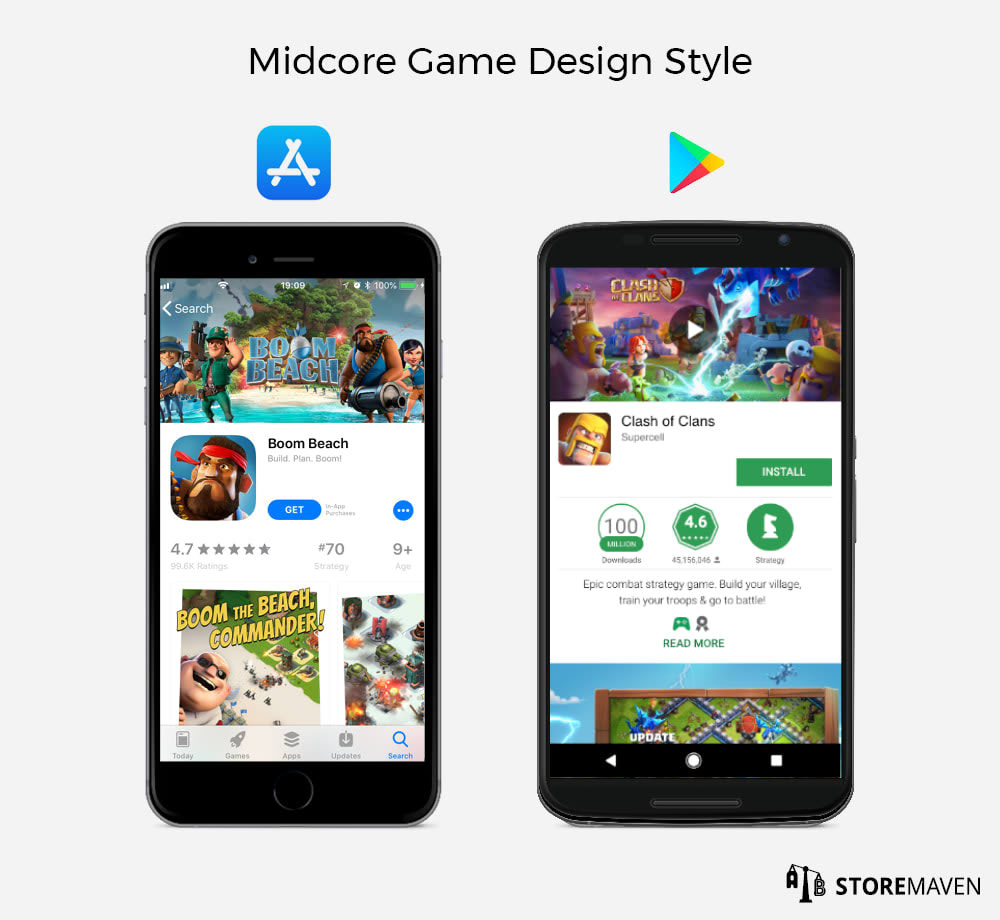
Midcore games usually find a way to creatively blend the styles. The graphics are highly detailed and elaborate like hardcore games, but they incorporate a more cartoon-like character art style. An interesting trend we’ve seen is the use of both light and dark colors within the assets, which is a unique way of combining the two game categories. The main visual elements tend to showcase a variety of characters against a backdrop of the elaborate worlds players can explore.
Given the major role characters play in your game, there are a variety of tests you can run to find the most impactful way of showcasing them in your Icon and other app store creatives:
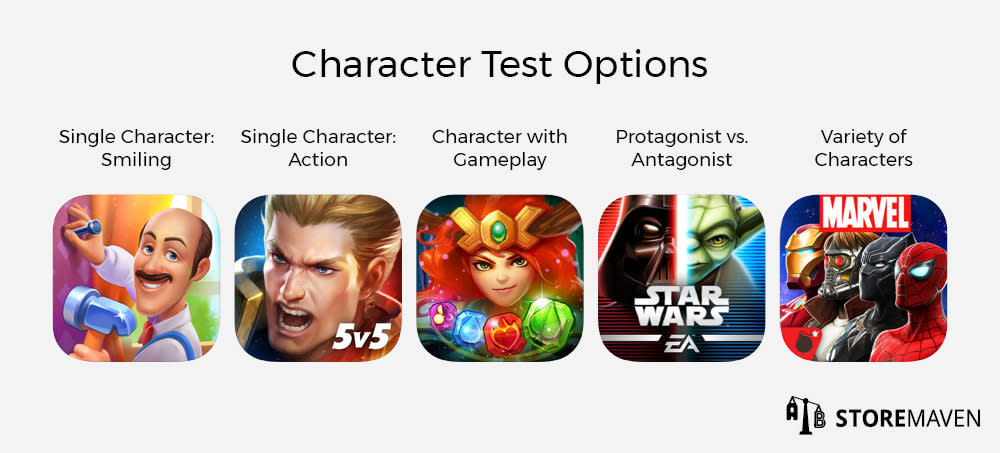
- Highlighting a single character
- Should they be more accessible and smiling, or does it convert better if they’re shown in action with more intense emotion?
- Combination of character and gameplay elements
- Antagonist versus protagonist
- Showing a group of characters
It’s not enough to just include your character(s) in the Icon or Gallery assets and call it a day. Your target users will have a preference, and testing is the only data-driven way to fully understand which character (or character combinations) your target audience responds the best to, and which they dislike. In fact, data from tests we’ve run with leading game publishers show that switching just one character in the Icon while keeping all other assets the same can potentially boost CVR by 20%.
At the end of the day, the unique way you display your characters in the app stores can have a huge impact on your overall conversion. For this reason, it’s important to implement an effective test plan and strategy to leverage them effectively.
Conclusion
While midcore games represent a growing opportunity within the lucrative gaming industry, and our post mostly focused on the midcore genre, these tips remain true for every game out there. The gaming industry itself is highly saturated ecosystem that requires all developers to adopt an effective ASO strategy to cut through the clutter and drive installs.

















